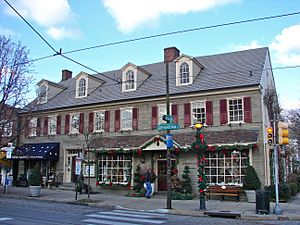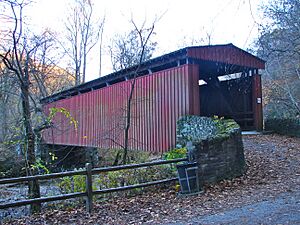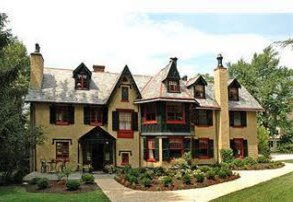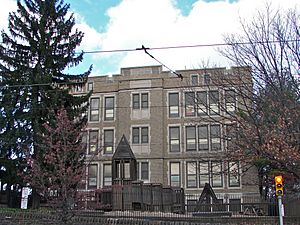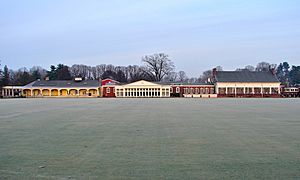Chestnut Hill, Philadelphia facts for kids
Quick facts for kids
Chestnut Hill
|
|
|---|---|
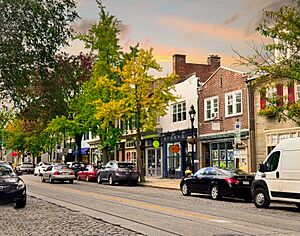
The Chestnut Hill business district
|
|
| Country | |
| State | Pennsylvania |
| County | Philadelphia |
| City | Philadelphia |
| ZIP code |
19118
|
| Area code(s) | 215, 267 and 445 |
Chestnut Hill is a cool neighborhood in the Northwest Philadelphia part of Philadelphia, Pennsylvania, in the United States. It's known for its beautiful homes and great schools. Many people who live here have good jobs and the houses can be quite valuable.
Contents
Exploring Chestnut Hill's Location
Where is Chestnut Hill?
Chestnut Hill has clear borders that help define where it is. These borders are:
- To the northwest: Northwestern Avenue. This road is also a county and city line.
- To the west: The Wissahickon Gorge. This is a beautiful part of Fairmount Park.
- To the northeast: Stenton Avenue. This is another county and city line.
- To the southeast: The Cresheim Valley. This is also part of Fairmount Park.
Understanding the ZIP Code
The USPS doesn't officially name neighborhoods for every ZIP code in Philadelphia. They just call them "Philadelphia." However, the 19118 ZIP code is almost exactly where Chestnut Hill is located. So, if you see 19118, you know you're in Chestnut Hill!
The Story of Chestnut Hill
The area we now call Chestnut Hill was first settled as part of German Township. This was set up by Francis Daniel Pastorius. It included smaller settlements like Sommerhausen and Crefeld. Chestnut Hill was an important gateway between Philadelphia and the farms nearby.
During the American Revolutionary War (in the late 1700s), Chestnut Hill became a popular summer vacation spot. Why? Because it's higher up, about 400–500 feet (120 to 150 meters) above sea level. This meant it was cooler than the busy city center. Even today, Chestnut Hill is known as one of Philadelphia's more well-off areas.
In 1854, Chestnut Hill officially became part of the City of Philadelphia. This happened because of the Act of Consolidation, 1854. In the same year, the Chestnut Hill Railroad opened. This made it much easier for people to travel to and from Center City. Later, in 1884, a second railway line was added.
During the American Civil War, Chestnut Hill was home to Mower U.S. Army General Hospital. This hospital cared for soldiers from the Union army.
From the mid-1800s to the mid-1900s, Chestnut Hill was a "railroad suburb" and a "streetcar suburb." This means people lived here and commuted to work in the city using trains or trolleys. It was a leafy, quiet place to live, even though it was part of Philadelphia. You can still see many beautiful old homes from the 19th and early 20th centuries.
In 1985, Chestnut Hill was recognized as a Historic District. This means its special buildings and natural beauty are protected. The American Planning Association even called it one of the "Great Places in America."
Amazing Architecture in Chestnut Hill
Chestnut Hill has many cool and historic buildings. Some of them are listed on the National Register of Historic Places. Here are a few examples:
- Anglecot (built 1883), designed by Wilson Eyre.
- Druim Moir Historic District, which includes a large Romanesque Revival mansion (1883–86).
- Graver's Lane Station (1883), designed by Frank Furness.
- John Story Jenks School (1922), designed by Irwin T. Catharine.
- Thomas Mill Bridge: This is the only traditional covered bridge in Philadelphia.
- Wissahickon Inn (now Chestnut Hill Academy) (1883–84).
- The Margaret Esherick House, designed by famous architect Louis Kahn (1959-1962).
Other notable buildings include:
- High Hollow, The George Howe House (1914–17).
- Inglewood Cottage (1850).
- Esherick House (1961).
- Vanna Venturi House (1962–64).
Getting Around: Public Transportation
Public transportation in the Philadelphia area is managed by SEPTA. This stands for Southeastern Pennsylvania Transportation Authority.
Train Lines
Two SEPTA Regional Rail train lines serve Chestnut Hill. These are the Chestnut Hill East Line and the Chestnut Hill West Line. They help people commute to and from Center City.
Bus Routes
Chestnut Hill also has several SEPTA bus routes. These include routes 23, 77, L, 94, and 97. Buses help people get around the neighborhood and to other parts of the city.
Trolleys: A Look Back
Trolleys are like electric streetcars. Chestnut Hill used to have trolley service starting in 1894. You can still see the old trolley tracks on Germantown Avenue, the main street. Regular trolley service stopped in 1992. For a few years, there was weekend-only service.
Even though some parts of the trolley system were fixed up in 2010, SEPTA currently has no plans to bring back regular trolley service on Route 23. Many local residents would like to see the trolleys return.
Learning in Chestnut Hill
Colleges and Universities
- Chestnut Hill College is a university located right in the neighborhood.
Schools for Kids
Public Schools
Students living in Chestnut Hill attend schools run by the School District of Philadelphia. Kids in kindergarten through 8th grade go to John Story Jenks School. Older students, in grades 9 through 12, attend Roxborough High School.
Private Schools
Chestnut Hill is also home to several private schools.
- Springside Chestnut Hill Academy teaches students from pre-kindergarten all the way through 12th grade. It was formed in 2010 when two schools, Springside School and Chestnut Hill Academy, joined together.
- The Crefeld School is for grades 7-12.
- Norwood-Fontbonne Academy is for kindergarten through 8th grade.
Other private schools nearby that some Chestnut Hill residents attend include Germantown Friends School, William Penn Charter School, and Germantown Academy.
Public Libraries
The Free Library of Philadelphia has a branch right in Chestnut Hill. It's called the Chestnut Hill Branch and is located at 8711 Germantown Avenue. It's a great place to find books and learn!
Fun and Green Spaces
Chestnut Hill has many parks and green areas where you can relax and enjoy nature:
- Morris Arboretum of the University of Pennsylvania
- Pastorius Park
- Wissahickon Valley Park (part of the Fairmount Park system)
The community used to host a very popular Harry Potter Festival. In 2017, about 50,000 people attended! However, the event was stopped in 2018 because of copyright rules. In 2019, the festival returned with a new name: the Witches & Wizards Festival.
Other Important Places
- Philadelphia Cricket Club: A historic sports club.
- Wissahickon Skating Club: A place for ice skating.
- Woodmere Art Museum: An art museum focusing on Philadelphia artists.
Famous People from Chestnut Hill
Many interesting people have lived in Chestnut Hill, including:
- Willie Anderson, a golfer who won four U.S. Opens.
- James Bond, an ornithologist (someone who studies birds). He's the namesake for the fictional secret agent!
- Joseph S. Clark, a former U.S. senator and mayor of Philadelphia.
- Philo Taylor Farnsworth, an inventor and pioneer of television.
- William J. Green, III, a former mayor of Philadelphia.
- Henry H. Houston, a railroad businessman and developer.
- David Morse, an actor.
- Georges Perrier, a famous chef.
- Henry C. Pitz, an illustrator.
- Frank Rizzo, a former police commissioner and mayor of Philadelphia.
- Brian L. Roberts, the CEO of Comcast Corporation.
- Hugh Scott, a U.S. Congressman and senator.
- Frederick Winslow Taylor, an engineer and management expert.
- Robert Venturi, a famous architect.



